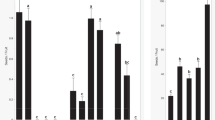Summary
The Endosperm Balance Number (EBN) hypothesis can explain to a considerable degree the crossability between tuber-bearing Solanum species. It has been shown to be genetically controlled and is dosage dependent. There is a good correlation between EBN and the postulated evolution and present taxonomy of potatoes. The primitive white stellate-flowered species from Mexico are 1EBN, and this condition is also found in species from South America with flowers of the same colour and shape. The evolution of a rotate corolla seems to be correlated with 2EBN. It is postulated that the 2EBN state arose as a reproductive isolating mechanism in South America. The taxonomic and evolutionary implications of the EBN hypothesis are discussed.
Similar content being viewed by others
References
Astley D, Hawkes JG (1079) The nature of the Bolivian weed potato species Solatium sucrense Hawkes. Euphytica 28:685–696
Bamberg JB, Hanneman RE Jr (1990) Allelism of Endosperm Balance Number (EBN) in Mexican tuber-bearing Solatium species. Theor Appl Genet 80:161–166
Chávez R, Brown CR, Iwanaga M (1988a Transfer of resistance to PLRV titer buildup from Solanum etuberosum to a tuber-bearing gene pool. Theor Appl Genet 76:129–135
Chávez R, Jackson MT, Schmiediche PE, Franco J (1988b) The importance of wild potato species resistant to the potato cyst nematode, Globodera pallida, pathotypes P4A and P5A, in potato breeding. II. The crossability of resistant species. Euphytica 37:15–22
Chávez R, Schmiediche PE, Jackson MT, Raman KV (1988c The breeding potential of wild potato species resistant to the potato tuber moth, Phthorimaea operculella (Zeller). Euphytica 39:123–132
Clugston DB (1988) Embryo culture and protoplast fusion for the introduction of Mexican wild species germplasm into the cultivated potato. Ph.D thesis, University of Birmingham, UK
Cribb PJ, Hawkes JG (1986) Experimental evidence for the origin of Solanum tuberosum subspecies andigena. In: D'Arcy WG (ed) Solanaceae: biology and systematics. Columbia University Press, New York, pp 383–404
Debener T, Salamini F, Gebhardt C (1990) Phylogeny of wild and cultivated Solanum species based on nuclear restriction fragment length polymorphisms (RFLPs). Theor Appl Genet 79:360–368
Den Nijs TPM, Peloquin SJ (1977) The role of endosperm in hybridization. Am Potato J 54:488–489 (abstr)
Ehlenfeldt MK, Hanneman RE Jr (1984) The use of Endosperm Balance Number and 2n gametes to transfer exotic germplasm in potato. Theor Appl Genet 68:155–161
Ehlenfeldt MK, Hanneman RE Jr (1988) Genetic control of Endosperm Balance Number (EBN): three additive loci in a threshold-like system. Theor Appl Genet 75:825–832
Gell PGH, Hawkes JG, Wright ST (1960) The application of immunological methods to the taxonomy of species within the genus Solanum. Proc R Soc Ser B 151:364–383
Hanneman RE Jr (1983) Assignment of Endosperm Balance Numbers (EBN) to the tuber-bearing Solanum species. Am Potato J 60:809–810 (abstr)
Hanneman RE Jr (1985) Assignment of Endosperm Balance Numbers (EBN) to the tuber-bearing Solanum species. Am Potato J 62:429 (abstr)
Hanneman RE Jr, Bamberg JB (1986) Inventory of tuber-bearing Solanum species. University of Wisconsin-Madison, USDA Bull 533
Hanneman RE Jr, Ehlenfeldt MK (1984) The use of Endosperm Balance Number (EBN) concept in potato improvement. Abstr 9th Triennial Conf Eur Assoc Potato Res, Interlaken, Switzerland, pp 99–100
Hanneman RE Jr, Peloquin SJ (1968) Ploidy levels of progeny from diploid-tetraploid crosses in the potato. Am Potato J 45:255–261
Hawkes JG (1988) The evolution of cultivated potatoes and their tuber-bearing wild relatives. Kulturpflanze 36:189–208
Hawkes JG (1989) Nomenclatural and taxonomic notes on the infrageneric taxa of the tuber-bearing Solanums (Solanaceae). Taxon 38:489–492
Hawkes JG (1990) The potato — evolution, biodiversity and genetic resources. Belhaven Press, London
Hawkes JG, Hjerting JP (1989) The potatoes of Bolivia — their breeding value and evolutionary relationships. Oxford University Press
Hermsen JGTh (1984) Some fundamental considerations on interspecific hybridization. Iowa State J Res 58:461–474
Hosaka K, Ogihara Y, Matsubayashi M, Tsunewaki K (1984) Phylogenetic relationship between the tuberous Solanum species as revealed by restriction endonuclease analysis of chloroplast DNA. Jpn J Genet 59:349–369
Jackson MT, Rowe PR, Hawkes JG (1978) Crossability relationships of Andean potato varieties of three ploidy levels. Euphytica 27:541–555
Johnston SA, Hanneman RE Jr (1978) Endosperm balance factors in some tuber-bearing Solanum species. Am Potato J 55:380 (abstr)
Johnston SA, Hanneman RE Jr (1980a Support of the Endosperm Balance Number hypothesis utilizing some tuberbearing Solanum species. Am Potato J 57:7–14
Johnston SA, Hanneman RE Jr (1980b) The discovery of effective ploidy barriers between diploid Solanums. Am Potato J 57:484–485 (abstr)
Johnston SA, Hanneman RE Jr (1981) The discovery of one additional Endosperm Balance Number (EBN) in diploid Solanum species. Am Potato J 58:505–506 (abstr)
Johnston SA, Hanneman RE Jr (1982) Manipulations of Endosperm Balance Number overcome barriers between diploid Solanum species. Science 217:446–448
Johnston SA, Den Nijs TPM, Peloquin SJ, Hanneman RE Jr (1980) The significance of genic balance to endosperm development in interspecific crosses. Theor Appl Genet 57:5–9
Marks GE (1966) The enigma of triploid potatoes. Euphytica 15:285–290
Ross H (1986) Potato breeding: problems and perspectives. Plant breeding no 37. Parey, Berlin Hamburg
Author information
Authors and Affiliations
Additional information
Communicated by G. Wenzel
Rights and permissions
About this article
Cite this article
Hawkes, J.G., Jackson, M.T. Taxonomic and evolutionary implications of the Endosperm Balance Number hypothesis in potatoes. Theoret. Appl. Genetics 84, 180–185 (1992). https://doi.org/10.1007/BF00223998
Received:
Accepted:
Issue Date:
DOI: https://doi.org/10.1007/BF00223998




